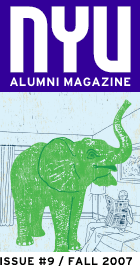cooking
Test Tube Food
Cuisine moves out of the kitchen and into the lab
by Sabine Heinlein / GSAS '07
At a recent gathering of NYU's Experimental Cuisine Collective, chemists, nutrition experts, cooks, and food writers hesitantly poured a white powdery substance onto their hands and licked it. The freeze-dried coconut powder was a pleasant twist on its commercially popular, spray-dried counterpart and, being organic, lacked the chemical additives and soapy aftertaste. It's exactly the sort of product that can evolve from molecular gastronomy, a movement that draws on chemistry and physics to better understand food preparation—how to naturally transform what we eat, harness its nutritional properties, and provide radical alternatives to the standard fare that lines supermarket shelves.Last April, chemistry professor Kent Kirshenbaum, creator of the coconut concoction, launched the collective along with chef Will Goldfarb, renowned for his technical innovations at Soho's Room 4 Dessert, and Amy Bentley, associate professor in the Department of Nutrition, Food Studies, and Public Health at the Steinhardt School of Culture, Education, and Human Development. Together, they regularly conduct food experiments and gather industry figures ranging from a New York Times food writer to a neuroscience professor from the Mount Sinai School of Medicine to investigate such questions as why soufflés rise. "How can we control the properties of food substances?" Kirshenbaum asks. "How can we get something to taste good?"
Apparently these queries interest more than just foodies. With adult obesity rates soaring to almost 33 percent in the United States, according to the Centers for Disease Control and Prevention, such culinary tinkering could shed new light on food processing and how it affects health. "It's really important that the public understand what a trans fatty acid is," Kirshenbaum explains, "and how the incorporation of these molecules in their foods have health consequences." The collective recently secured $10,000 from NYU's Humanities Initiative and $14,000 from the University Research Challenge Fund for ingredients and tools to test and produce new foods, such as a puffed onion ring created by famed molecular gastronomist Wylie Dufresne, who owns the Lower East Side restaurant wd~50. Dufresne's snack is firmer, with fewer artificial ingredients, and tastes more like pure onion than Frito-Lay's Funyuns.
While chefs have dabbled in science for centuries, the term "molecular gastronomy" was coined by Hervé This, a physical chemist at the French National Institute for Agricultural Research and the keynote speaker at the collective's inaugural symposium. Over the past quarter century, This has scientifically tested hundreds of old wives' tales, including how best to center the yolk of a hard-boiled egg (the key is not to simply plunge it in already boiling water, as most chefs believe, but to keep the egg rolling around the pot for 10 minutes). After two decades of waffling between fringe movement and fad, molecular gastronomy is infiltrating more U.S. kitchens, most notably among experimental chefs such as Daniel Patterson at Coi in San Francisco, Grant Achatz at Alinea in Chicago, and Goldfarb. But it also appeals to those who seek empowerment at home. "When I cook I want to know why I'm doing what I'm doing," says Patricia Gadsby, a contributing editor at Discover magazine, who attended one of the collective's recent events.
For now, however, most research takes place far away from trendy restaurants and homey kitchens because the work requires more elaborate equipment than a trusty frying pan. Kirshenbaum recently employed a powerful freeze-drying apparatus to develop a concentrated port wine "gum." "There are some very nice antioxidant compounds in red wine," he notes, "and we anticipate that those would be retained in these freeze-dried materials." So far, the process has preserved the wine's powerful aroma and eliminated its alcohol content, but also robbed it of elasticity, leaving a hard lump in the test tube. Port wine rock candy, anyone?
Photo Illustration © Rick's Imageworks








